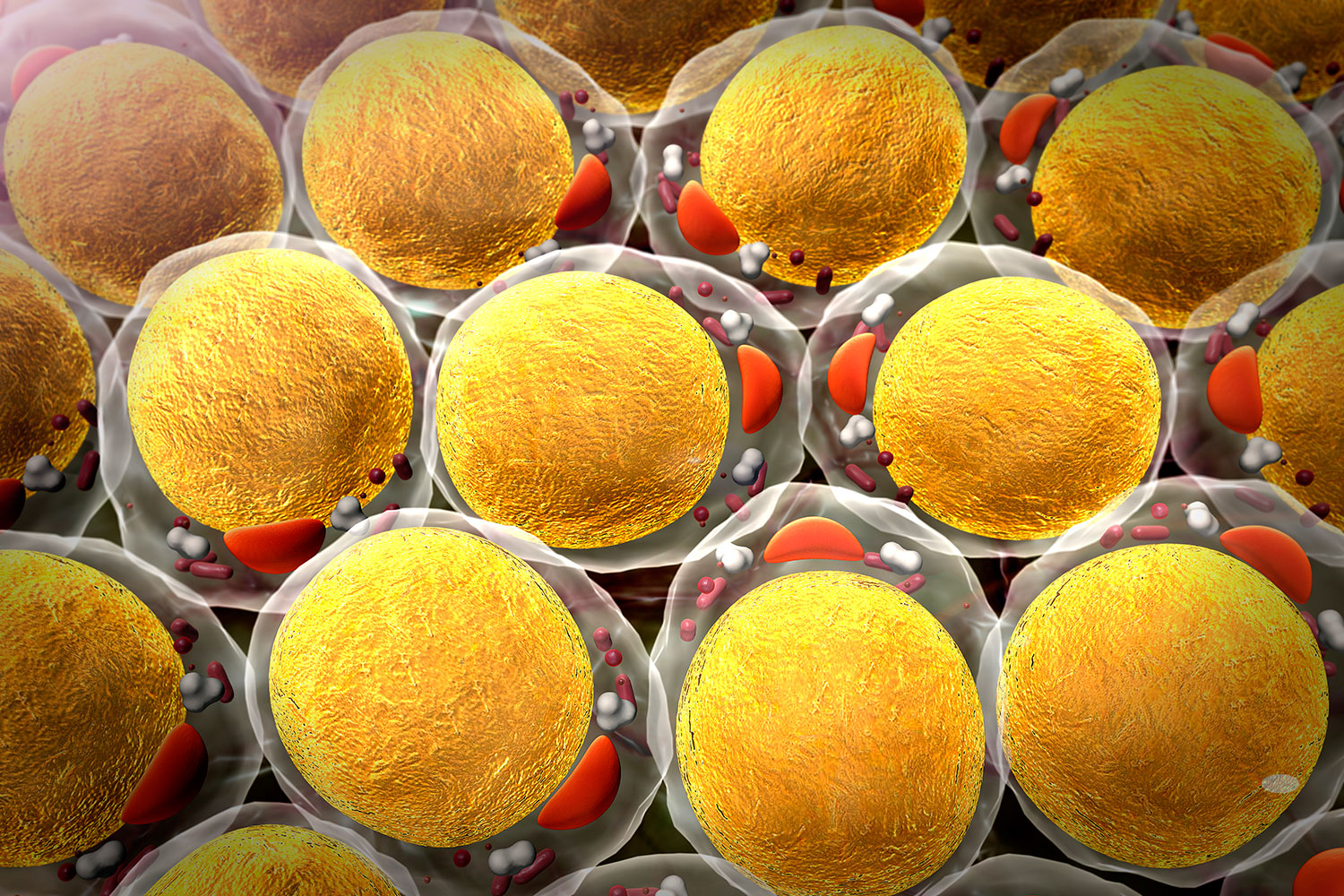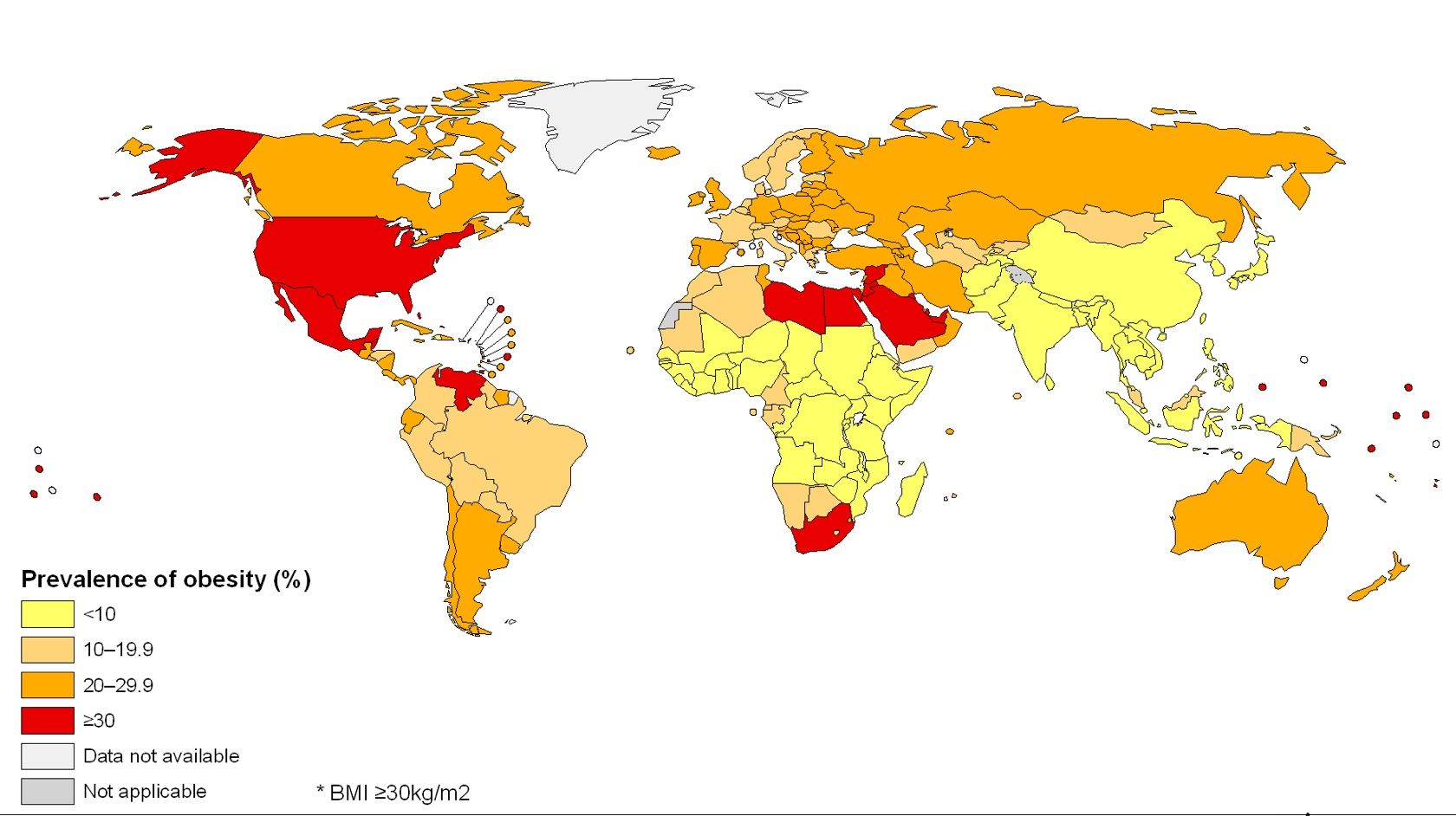Striking Statistics and advanced Information on Obesity - Human Energy Metabolism #5
This is my fifth and presumably last article on the Human Energy Metabolism. I would like to dedicate this article to the discusson of some bacics as well as advanced principles of nutritional biochemistry and also some interesting statistics related to the topic of obesity.
Obesity - an epidemic Problem

Illustration of adipocytes of the adipose tissue - Image Source
First of all we have to answer one basic question:
How you do define or measure obesity?
The assessment of the body weight related to the square of the body height is a well established methodology and is generally known as the Body Mass Index, or short the BMI.
From this definition, a nice overview of the different body mass conditions depending on the BMI can be derived:
click to enlarge
As you can see, there are different degrees of adipositas. The classification of obesity into three different degrees of severity makes sense from a medical point of view. On the one hand, because the risk of secondary diseases varies according to the severity of obesity and on the other hand, because also the therapy may vary.
Obesity is a health risk
In the following graphs the relative risk for cardiovascular disease (A) and cancer (B) are plotted against the BMI. In this study as many as 115.195 nurses participated in a 16 year-trial. All of which were non-smokers. The relative risk of those with a BMI under 19.0 was set at unity. The results show that death due to cardiovascular disease was four times higher in obese women, when compared to the rate for the leanest women.

click to enlarge
There seemed to be some association of obesity with cancer, though this association was clearly less dramatic than for cardiovascular disease (risk was "only" 2-fold higher). Furtermore obesity is a strong risk factor in developing Type II Diabetes.
In some cases, obesity itself is not a disease of its own, but a symptom caused by another disease. Examples for this case would be Hypothyroidism or the Cushing syndrome, second of which is caused by an overproduction of the hormone cortisone.
Causes for Obesity
A) Chronic imbalance between caloric uptake and the real physical need
Protein and glycogen stores are regulated within very narrow limits. Fat reserves, however, can grow enormously, resulting in the build-up of adipose tissue. The formation of adipocytes is largely a result of a diet rich in fatty acids, i. e. percentage of body fat roughly correspond to dietary fat content.
B) Behavioral factors
Eating habits as well as the amount of physical activity very much influence above mentioned imbalance. 30 min daily physical exercise are recommended.
C) Educational & social factors
The replacement of traditional local diets by global Western diet, as well as the lack of knowledge concerning healthy food are two major factors. Furthermore there is a non-surprising connection between the income of families and their caloric uptake. Since fat and sugars are overwhelminlgy sold rather cheap, low income families tend to consume high caloric diets.
D) Inborn disturbances
Mutations in genes linked to fat or energy metabolism may also be the causes for obesity. At this point, leptin or the associated leptin receptor may be mentioned as suitable examples.
The Role of Leptin
Leptin (Greek: leptos = thin) is a 16 kDa polypeptide produced by adipocytes. Leptin was first discovered in homozygous mice carrying a defect in the OB (obese) gene. Humans do indeed have a homologous protein (ca. 84 % identical). As a result these mice tend to overeat and have twice the body weight as normal mice.
click to enlarge
Leptin acts as a satiety signal resulting in reduced food uptake. This was shown by leptin-treated OB homozygous mice, which lost 50 % more body weight than untreated mice on the same calory restricting diet. This suggests that leptin also controls energy expenditure (probably in skeletal muscles!).
Leptin binds to the leptin receptor OB-R, a transmembrane protein, predominantly expressed in a brain region called Hypothalamus. The hypothalamus produces Neuropeptide Y (36 amino acids long) what is known to act as an eating signal. Upon binding of leptin to OB-R, the production of this specific peptide is inhibited.
OB-R appears in at least six variants resulting from tissue-specific splicing.
The Formation of Energy Stores
The processes of our body - a sophisticated biochemical machinery - have an efficiency unequal to 100 %. This means that the build-up of energy storages is associated with some kind of inefficiency, hence energetic loss. However, this strongly depends on the particular biochemical pathway and thus on the macronutrients consumed. This fact is shown in more detail in the next representation.
click to enlarge
Conclusions:
- Dietary fats are stored directly and with high energy yield.
- Carbohydrates are stored in the glycogen stores. These are limited and excess of carbohydrates is converted to fatty acids, which in turn are stored in adipocytes.
- Therefore growth of adipose tissue is mainly a result of too much fat intake!
- However, excessive uptake of carbohydrates (and protein) can also lead to growth of adipose tissue!
Overview of the Epidemic

Global Prevalence for Obesity - click to enlarge
Image Source
Although this data is taken from the year 2008 it is still quite representative. For very much detailed and more recent information, also within single countries, have a look at the interactive WHO Database.
Between 1985 and 2008, there was a study called Behavioral Risk Factor Surveillance System (short BRFSS) in America, which looked at the incidence of obesity. These studies provided impressive and clear results proving an unfortunate trend. Take a look at them:

This concludes my series on the Human Energy Metabolism. I hope I was able to provide some interesting insights. Follow and support my work for more chemical, biochemical, physiological or general scientific articles.
Previous articles of this series can be found here:
- Part #1 - Organ-specific Requirements
- Part #2 - The Respiratory Quotient
- Part #3 - Diabetes mellitus
- Part #4 - Fasting and Starvation
mountain.phil28
References:
- Fit & Leicht articles: 1, 2, 3
- WHO Global Health Observatory (GHO) Data
- BRFSS, Behavioral Risk Factor Surveillance System, Prevalence of Obesity Among Adults, 2007, MMWR 2008, 57(36), 765-8
- Further information and non-direct cited images are taken from "Biochemistry I" lectures at the TU Graz.
You state here for males that below 20 is underweight but almost everywhere else that I have been/read this it has been saying below a BMI of 18 is underweight for males. This brings questions to my mind since, from my most recent weighing I would have a BMI of around 18 (rounds to 58.6 KG and around 1.8 meters), would there be any major risks associated with being underweight that you can think of?
I am not replacing going to the doctor with this question and I know it is slightly off topic as this post is about being overweight. I have been to a doctor about my weight but when taking a family history it is noted that males in my family typically, even at older ages, are very slim and have a relatively low BMI. My question though arises at your new definition point of what underweight is compared to here and I was wondering if there is a reason it is defined as 20 and if there are known risks for having it lower?
Thank you very much for your comment and questions. So here we go:
Depending on the health organization/source referred to, there are varying degrees and divisions of the BMI. To keep it as easy to understand as possible, I have not listed so many subdivisions, but gave ranges for which they in general agree. The range from 20-25 is generally accepted as "normal" and the range from 18.5 to 20 is in some sources referred to as "slightly underweight". (1, 2)
So if you have a BMI indicatin a "sligthly underweight" state many physicians would view you as still fine, but you should try not to lose more weight or maybe even gain some.
In general being "slightly underweight" from the point of view of a Western lifestyle is considered as something quite beneficial for longevity. (3)
Nonetheless there are some links between being slim or even underweight to the development of some diseases. E.g. Chronically inflammatory bowel disease statistically more often affects thin than obese people. But it is not yet clear whether the underweight favors the disease or whether both are just symptoms of another predisposition. Finally, a clear indication of the relationship between general mortality and the BMI.
Source 3
I hope I answered your question!
Best,
mountain.phil28
Well I will continue to try to gain weight, in a healthy manner (as in I wont eat a super large amount of candy or soda pop etc and sit around doing nothing) and yeah you answered. The graphs are quite a nice touch, I just wanted a response more so I could upvote you twice to reward you accordingly.
That's very nice of you.
Wish you all the best!
Information is not knowledge.
- Albert Einstein
~Knowledge IS power.~ -Francis Bacon
Information generates knowledge. Knowledge become power
seems a informative post bro. keep it up.
woohoo awsoem subject :D
Hm either my english is of base ^^ jupp that dooo happen :P can we talk about > Causes for Obesity- Behavioral factors
Eating habits as well as the amount of physical activity very much influence above mentioned imbalance. 30 min daily physical exercise are recommended.' Hm shouldnet it be added'- todays humans, sit at work, we are actually made to workout the food we eat, so its a socializing aspekt to be considered here! Todays humans also have a lot fo stress which kick in insuline which in its turn, turn on our 'eating' habbits and insuline do attract fat, sneaky sob :p soo we have a hole smorgous board here which i find should be added or at least voiced :)
Please explaine -However, excessive uptake of carbohydrates (and protein) can also lead to growth of adipose tissue!' i get what your saying but there is a huuge difference betwin protein & carbs.. so you lost me.. :(
Stellar work sweetypie :D jiiPpy you :D well written, point on <love the refs ;) LOL
Both carbohydrates and proteins can be degraded by inherent biochemical pathways of our body. If there is no acutal need for energy released by further catabolic degradation, the produced intermediate 'platform' compounds are used to build up fatty acids. This then allows the body to store the uptaken energy in a rather efficient way, for later usage.
If you want to have a more precise illustration I can look up the reaction sequences that occurs in this case. I do not know it by hard right know. :)
Oh ok Yeah i know this, just got wording lost il guess 😜 hi sweetness💗😀 hm Na No need as that i actually know lol tnx
ok, good to hear. :P :)
;) Hii youuu 🐲🐉💗🐲🐉💗🐲🐉💗 Me got wine, il join you :D and Mr is drinking wazz? :D <3 🐲🐉💗🐲🐉💗
<loadly Hollers at @mountain.phil 🐲🐉💗 -sweety, im at 3 glasses now, dont you dare to dump me :P ;) <3
I can't trink today - but happy to hear, that you can relax now. :)
hmmm...grooowles^^
ha ha did you just called me uptight? RATFLOL
<have massive work axciety :(
Uptight!!!!!! 😂🤣😁🤣😋😊😋